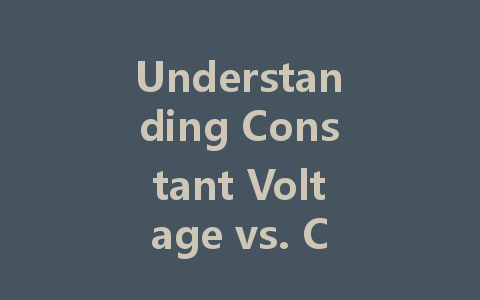In the world of LED (Light Emitting Diode) technology, drivers play a crucial role in ensuring the longevity and performance of lighting systems. Among their types, constant voltage and constant current LED drivers are prominent, each with its distinct applications, advantages, and limitations. This article will elucidate the fundamental differences between constant voltage and constant current LED drivers, helping you make an informed decision for your lighting needs.
Что такое светодиодные драйверы?
Драйверы светодиодов are power supply devices that provide the necessary voltage and current to operate LEDs effectively. Their primary function is to convert mains voltage into a level that is usable by LEDs, which typically operate at lower voltage levels. Depending on the specific requirements of the LED system, the driver can be classified into two main types: constant voltage and constant current drivers.
Светодиодные драйверы постоянного напряжения
Определение и функциональность
Constant voltage drivers maintain a consistent output voltage while allowing the current to vary. These drivers are ideal for applications where multiple LEDs are connected in parallel, such as LED strips. The standard output voltage for most constant voltage drivers is 12V or 24V, making them well-suited for general lighting purposes.
Приложения
Constant voltage drivers are commonly used in:
Преимущества
Limitations
Светодиодные драйверы постоянного тока
Определение и функциональность
In contrast, constant current drivers provide a fixed output current while allowing the voltage to fluctuate based on the load connected. This type of driver ensures that the LEDs receive the correct amount of current required for optimal performance, thus improving their lifespan and efficiency.
Приложения
Constant current drivers are typically applied in:
Преимущества
Limitations
Выбор между драйверами постоянного напряжения и постоянного тока
Consider Your LED Array
When selecting between constant voltage and constant current drivers, consider the configuration of your LED array. If you are dealing with a series connection of LEDs with varying specifications, a constant current driver is advisable. Conversely, if you’re connecting LEDs in parallel, opt for a constant voltage configuration.
Assess Your Application Requirements
The functional requirements of your lighting application should also influence your choice. For instance, decorative applications that utilize LED strips may benefit from constant voltage drivers, while high-efficiency street lighting will likely require the precision of constant current drivers.
Evaluate Cost and Complexity
Lastly, weigh the cost and complexity of implementation. While constant voltage drivers may be more economical and simpler to install, constant current drivers offer long-term savings through increased efficiency and reliability.
Заключение
Understanding the differences between constant voltage and constant current LED drivers is essential for achieving the best results in your lighting projects. By considering the application requirements, cost, and configuration of your LED systems, you can choose the right driver to ensure optimal performance and longevity of your lighting solutions. Investing time in this decision will pay off in the enhanced efficiency and effectiveness of your LED installations.
